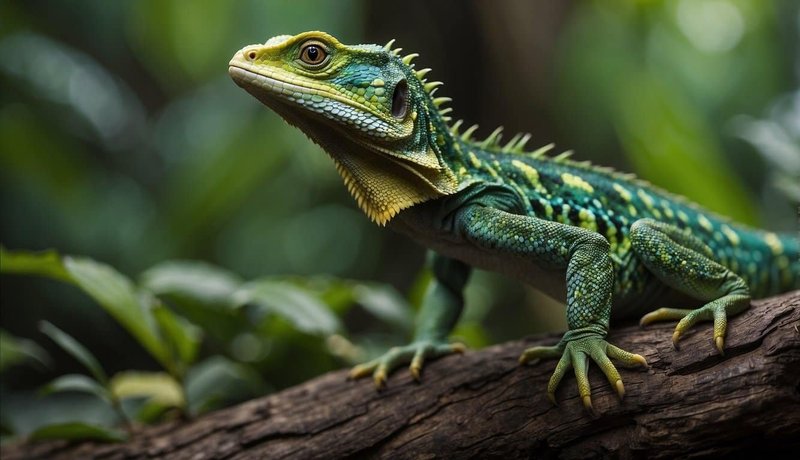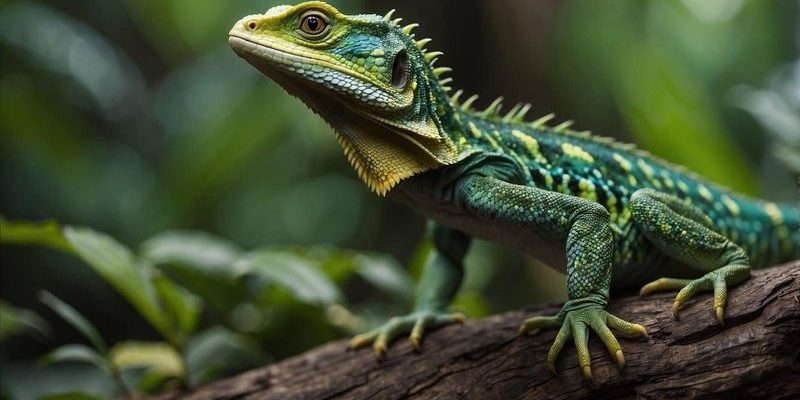
From the lush rainforests of Central and South America to their unique adaptations that allow them to escape predators and navigate their habitats, the evolutionary history of basilisk lizards is one for the books. Let’s dive deeper into their past, exploring how these stunning reptiles have developed into the remarkable creatures we admire today.
What Are Basilisk Lizards?
Basilisk lizards belong to the *Corytophanidae* family and are native to the warm, tropical regions of Central and South America. There are several species of basilisk lizards, including the green basilisk (*Basiliscus plumifrons*) and the brown basilisk (*Basiliscus vittatus*). One of the most striking features of these lizards is their stunning coloration, which can range from vibrant greens to earthy browns.
These lizards are medium-sized, typically measuring between 2 to 3 feet in length, including their tails. They have a distinctive crest running along their heads, backs, and tails. This crest isn’t just for show—it plays a role in their mating rituals and helps them communicate with each other. When you see a basilisk, you might first notice its long toes, which help it sprint across water surfaces, sometimes at speed approaching 5 feet per second. Imagine trying to outrun a hungry predator while skimming across a lake!
The Origins of the Basilisk
The evolutionary history of the basilisk lizard dates back millions of years. It’s believed that these lizards diverged from their common ancestors during the late Cretaceous period, around 70 million years ago. This means that while dinosaurs roamed the Earth, early ancestors of the basilisk were starting their journey toward becoming the unique reptiles we know today.
During this time, the climate in Central and South America was quite different. The lush forests we see today were beginning to flourish, offering a perfect environment for these lizards to evolve. Over time, various adaptations—like their water-running abilities—developed as a response to their environment and predators. It’s fascinating to think about how they adapted to survive in the ever-changing climate and landscape of their habitats.
Adaptations for Survival
Survival in the wild isn’t a walk in the park, especially when you’re a small lizard. Basilisk lizards have developed some impressive adaptations to escape predators and thrive in their habitats. For starters, their ability to run on water is one of the most remarkable evolutionary traits. By rapidly moving their feet, they create small air pockets under their toes, allowing them to “run” on the water’s surface. This ability is not just for show; it can literally save their lives when they’re being chased.
Beyond their water-running skills, basilisk lizards have evolved other adaptations for survival. Their slender bodies and long limbs help them navigate through dense vegetation, making it easier to escape from hungry hawks or snakes. Additionally, their coloration serves as a form of camouflage, blending them into the leafy surroundings. Imagine trying to spot a basilisk in the wild; it can be quite a challenge!
Social Behavior and Mating
The basilisk lizard isn’t just about survival; it also has a rich social life. These lizards are known for their territorial behaviors, especially during the mating season. Male basilisks display their vibrant colors and impressive crests to attract females and ward off rivals. This display can be likened to a peacock showing off its feathers—both are trying to win over a mate!
During courtship, the male will often bob his head and engage in push-up displays, showcasing his strength. If a female is interested, she’ll respond positively by also bobbing her head. Their social interactions help ensure that the strongest genes are passed on to the next generation, continuing the cycle of evolution.
Environmental Impact on Evolution
As the climate and ecosystems have changed over time, basilisk lizards have had to adapt continually. The shifting climates of Central and South America, ranging from warm, tropical environments to more arid areas, have influenced their evolution. These changes have led to variations between species, as some adapted to specific habitats better than others.
For example, the green basilisk is often found in areas with a lot of water, while the brown basilisk tends to thrive in drier environments. Each species has developed unique traits suited to its habitat, showing how evolution works in response to environmental pressures. This idea can be summed up simply: those lizards that can best adapt to changes in their environment are the ones that survive and reproduce.
Human Influence on Basilisk Populations
Today, human activities continue to shape the evolutionary trajectory of basilisk lizards. Deforestation, urbanization, and pollution have led to habitat loss and fragmentation, disrupting these lizards’ natural environments. As a result, some species are becoming endangered, which means they face a greater risk of extinction.
Conservation efforts are crucial to ensuring that these lizards can continue to thrive. By protecting their habitats and promoting awareness about their importance in the ecosystem, we can help safeguard the future of basilisk lizards and allow them to continue their evolutionary journey.
The evolutionary history of the basilisk lizard is a captivating tale of adaptation, survival, and resilience. From their impressive water-running abilities to their vibrant social displays, these creatures have adapted uniquely to their environments. As we continue to learn more about basilisk lizards, we gain insights not only into their lives but also into the broader story of evolution itself.
As we reflect on their journey, remember that every species, including the basilisk, is a product of its environment. The challenges they face today remind us of the importance of preserving our natural world. Let’s celebrate the incredible basilisk lizard and acknowledge the fascinating evolutionary path it has taken. After all, every creature plays a role in the grand tapestry of life on Earth!

